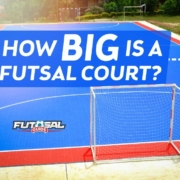When you first start playing futsal, you’ll notice that the positions seem more like basketball than soccer, you shouldn’t be overwhelmed though as they can be easily related to soccer but on a much smaller scale. There are several variations of how positions within futsal are used or what their names are, we’ve put together a comprehensive list of all the common positions and how they are used/defined.
So, What Are the Positions in Futsal? Traditionally futsal is made up of five positions, these positions are defined as:
- Goalkeeper
- Pivot/Target
- Wingers
- Defender
Futsal is a fluid sport meaning players assigned to these positions should be expected to play in all roles on the field as required to counter or take advantage of opposition teams. Different teams may employ variations on these traditional roles to suit their own customized tactics.
The Goalkeeper and Tipping The Balance…Sometimes!
Goalkeepers in futsal play a crucial role in the team, not only are goalkeepers relied upon to keep the goals out, but they are also able to turn the tide of play in almost an instant, this is because they can quickly launch a counterattack in the opposition’s half thus reversing the pressure.
Goalkeepers should be able to marshal their teammates and issue verbal commands in order to maintain a well-organized unit as they have complete oversight of the play unfolding in front of them and will be able to see things that other players may not.
Goalkeepers are able to handle the futsal ball within the goalkeeper’s “D” to stop opposition shots, keepers should be equipped with quick reflexes and agility to stop those hard to reach shots.
Crucially, keepers can also be used in what’s known as a “fly goalkeeper”, when utilized the goalkeeper abandons their goalkeeper duties and plays as an active fifth player on the court.
Obviously, this is done with a great deal of risk if the opposition gains control of the ball as the goal will be left unattended and defenseless.
Teams will usually employ this tactic when they are losing and need to chase the game, keepers need to be good with their feet and have a good level of composure.
It is important that futsal teams do practice this tactic at length in training so that everybody is not only familiar but are able to operate under pressure as small mistakes can be very costly.
Key rules to be aware of:
- Goalkeepers can only be possession of the futsal ball for four seconds in their own half under all circumstances
- Only one back pass is permitted, the futsal ball must touch an opposition player before another back pass can be player
- If playing as a fly keeper, when in the opposition half the keeper is treated like an outfield player and is not restricted to backpasses or time on the ball
The Top Man
The pivot, in park football we might call them the “goal hanger”, usually play a central role or up close by the goal.
Generally, this player should be comfortable being under close attention from opposition players as being a target for ball distribution will not go without defensive pressure from the other side.
It does help a pivot if they are able to hold of defenders using body strength but are also comfortable with controlling balls coming in at height and with pace.
Quite often a basic tactic employed will see goalkeeper playing the long ball to the pivot who will then simply lay off to a winger for a quick shot on goal.
Pivots will often have their back to the opposition goal so having the ability to turn defenders if they are isolated and without support will allow them to pepper the opposition goal.
When balls are played into the pivot it’s crucial that the other players on the team support them with flanking runs and movements to create dummy movements or be ready to receive the ball.
Personally, I’ve found it useful using players with a decent level of strength and the ability to hold of one if not two defenders for a period of time, that being said players with the “old bag of tricks” can be very effective in this role also.
The pivot, if deployed deep in the opposition half can be used to create space on the court, this is especially effective if your team’s wingers are superior in 1v1 situations to exploit the opposition.
Vaa Vaa Voom Wingers
Depending on what formations are used there can be one or two wingers deployed at any one time.
Wingers are usually versatile, fast and should have a few tricks up their sleeve to beat out opposition players in one on one situations.
Being able to create darting runs and play one-two passes with the Pivot will assist in the creation of space and goal scoring opportunities, the wingers will usually hug the touchline in a similar fashion to that of a soccer player and this allows for wider spaces to create more room for other position such as the pivot.
Wingers have somewhat of a license to roam on the futsal court and are pivotal in backtracking to provide cover goalkeepers but equally relied upon to support the pivot player.
It’s important that wingers have a good level of stamina as futsal is nonstop from start to finish any players lacking fitness will be found out early on at a disadvantage to their team.
The Defender
Defenders are the last stop, the last line, the one-man bus in futsal! Critically whoever is covering this position should have good communication skills and be able to stick a leg in when appropriate to not give away unnecessary fouls.
As futsal is fast and can change in the blink of an eye defenders can often become attackers in and dependent on the tactics employed all players may be required to fill the role of the defender or there may be multiple defenders, as with soccer and other sports tactics are always fluid and ever evolving on and off the pitch.
Super Subs
While not an official on field position the substitutes are part of the team and play a crucial role the teams’ success. Futsal rules stipulate that all teams can have up to 12 players in reserve.
Now when you do the basic math, there are enough players to cover all positions threefold.
Dependent on what the managers’ intentions are most players should be able to squeeze 10 minutes per game if played on a rotational basis, although not often used this way think for a second the kind of hell a team could unless if they had fresh players entering the field every 10-15 minutes with fresh legs.
When you bear in mind most amateurs sides could struggle to even fill a team this can be quite effective.
Are Their Variations to These Positions?
Of course, the positions listed here are just an example of the basic universal positions that are deployed in futsal. Each team may have a different idea on what positions do and how they are best used.
That’s what sport is about, evolution.
You’ll find for the most part that these positions will remain the same with slight variations though.
The Coaches
Futsal teams can at times struggle to fill key positions least of all coaching/management positions.
Coaches that do take on this field of sport and stick with it usually end up being somewhat successful particularly at an amateur level due to the short supply.
Players will generally “show up” for games but it’s integral that the team does apply futsal philosophy in order to succeed long term, a good coach will be able to get a team of soccer players to adapt their playing style to ensure on-court success.
Related Questions
What kind of uniforms do futsal player wear? Futsal teams will generally wear uniforms that are like soccer players. All outfield players will wear the same uniform except for the goalkeeper whose uniform will be different. Amateur competitions may differ, and bibs can be acceptable at certain tournaments.
Is there offside in futsal? There is no offside rule in futsal, this is particularly useful to teams as it will allow players to open the space of the futsal field and create space for teammates or apply pressure to the opposition with a constant attack threat.
Can a goalkeeper score with a throw-in futsal? Goalkeepers are not allowed to throw the ball over the halfway line, it must meet a player before the halfway line, if a goalkeeper’s throw crosses the halfway without this occurring it will result in a turnover to the opposition team.




 futsalguide.com
futsalguide.com 

 futsalguide.com
futsalguide.com 
